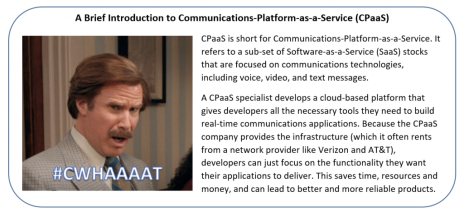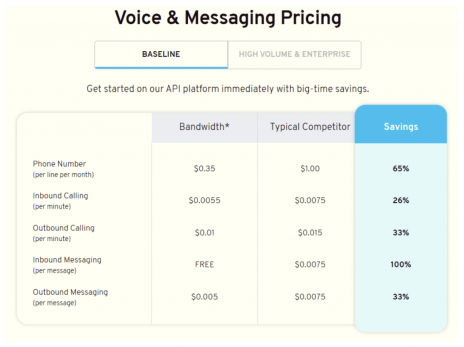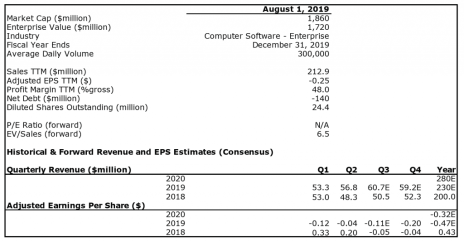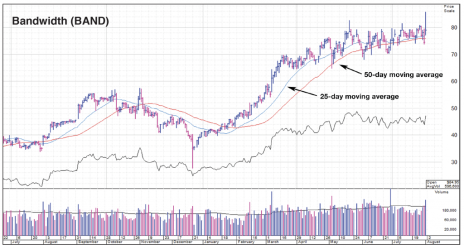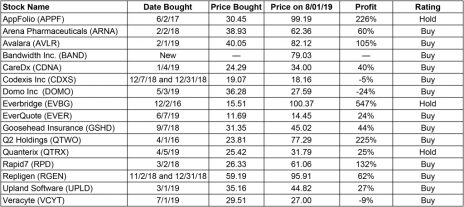Today’s recommendation is a software and infrastructure company specializing in communications. It just reported Wednesday night, and results were better than expected, which is great for two reasons.
First, the latest numbers support my thesis that this company has what it takes to grow over the long haul.
And second, we don’t need to stress about the company reporting right after we buy in! We have the latest data. And it looks good.
All the details are inside this month’s Issue.
Cabot Small Cap Confidential 243
[premium_html_toc post_id="183427"]
THE BIG IDEA
Back in the late 1800s if you called a company for information you were routed through a telephone exchange and were able to speak with a person that could help.
The last switchboard operator for a hand-crank phone, Susan Glines, walked away from her post in 1983. By 1991 the battery-powered switchboards shut down too.
For most enterprises, personal assistance from human operators became a thing of the past as we moved into the 2000s. The rise of recorded messages and maddeningly complex automated directories ruled the help lines.
Fortunately, the world is moving back in the right direction when it comes to customer service. It took two big sea changes to make this happen.
First, companies finally wised up to the reality that it’s cheaper to keep a customer than it is to get a new one. Ubiquitous use of software has helped many companies calculate their customer acquisition and retention costs down to the penny. Customer service and the resulting reputation is now a key differentiator.
Second, communications platforms are finally advancing to the point where they work across all the methods people use to get and keep in touch.
Take the example of a person shopping online for a new fridge. He or she browses online, puts two fridges that seem good in a shopping cart, then calls the help line. The agent that picks up already knows what’s been looked at and what’s in the cart. Deal closed and on to the next one.
This is possible because the retailer is using one platform infrastructure for all their communications services. This infrastructure is called Communications-Platform-as-a-Service (CPaaS).
How did they do it?
The retailer’s developers used software development kits (SDKs) and application programming interfaces (APIs) to quickly embed code into their applications that makes voice, messaging and even video services work on the same platform.
It sounds complicated, and it is on the back end for the infrastructure provider. But not for the retailer.
They didn’t need to build the infrastructure, and they don’t need to maintain it. Their developers just crank out the apps and the retailer pays based on usage. The more they use, the lower their average cost. The retailer also gets access to analytics that can help improve how they operate their business.
CPaaS is not only reversing the post-switchboard operator trend in poor service, it’s opening the door to completely new businesses and fueling growth for others.
Companies that offer communications software solutions, such as Ooma (OOMA) and Jive, run their entire businesses on CPaaS platforms provided by other companies. Google Voice and Microsoft’s Skype run on CPaaS platforms, too.
The apps of ride-share companies, including Uber (UBER), hotel and house booking services, including Airbnb, and many upstart telemedicine services only perform as they do because CPaaS functionalities have been embedded in them.
CPaaS solutions are becoming must-have business tools. Not only for the biggest companies out there, but also for small and mid-sized companies.
One small cap company is going after the big fish—and that’s the company I’m adding to our portfolio today.
THE COMPANY
Bandwidth (BAND) is a $1.9 billion market cap firm that has developed one of the leading cloud-based communications platforms available for large enterprises. This CPaaS platform helps customers build, scale and operate software-based voice, messaging and emergency service-related communications tools.
The end goal of this platform is to make it easy for customers to frequently and easily connect with existing and prospective customers, and to achieve operating efficiencies for employees.
Among many use cases, customers can develop new mobile applications that allow them to send Application-to-person (A2P) messages, receive Person-to-Application (P2A) messages, add voice calling to residential Internet of Things (IoT) and develop innovative 911-calling solutions that improve emergency response times by automatically identifying the call-from location with pinpoint accuracy.
You’ve most likely used the platform yourself by now. Zoom (ZM) is a customer and uses Bandwidth Voice to power its conferencing solution.
RingCentral (RNG) is another customer, and uses Bandwidth Voice, Messaging, and 911 Access to deliver an all-in-one communication solution to its customers.
Google (GOOG) uses Bandwidth Voice in its Google Home smart speaker to power outbound calls. Amazon’s (AMZN) Alexa does, too! And Microsoft (MSFT) also uses Bandwidth Voice and Messaging in some applications, including Skype.
The list of big customers goes on: Cisco (CSCO), ZipRecruiter, GoDaddy (GDDY), 8X8 (EGHT) and Rently are all customers. All in, Bandwidth has 1,467 customers (up 34% from a year ago), including about a dozen from the Fortune 1000. No customer makes up more than 10% of revenue.
As time marches on, many of these customers are increasing their business with Bandwidth, including two customers that are significantly ramping up services in the middle of 2019. This is a good sign as it shows the company’s significant investments in sales and marketing are paying off.
THE PLATFORM & PRODUCTS
Bandwidth generates most of its revenue from usage-based fees for voice communications (inbound and outbound minutes, as well as toll-free minutes), messaging communications (a volume game) and a variety of service fees related to provisioning and managing phone numbers and emergency services access.
One of the major distinguishing factors for Bandwidth, and a source of its competitive advantage, is that Bandwidth owns its own tier 1 network. That makes the company more similar to the legacy network providers like Verizon, AT&T and CenturyLink than the other CPaaS players, such as Twilio (TWLO), which all run their platforms on infrastructure provided by the network providers.
To offer its CPaaS solutions, Bandwidth has layered an Application Programming Interface (API) on top of its network. This allows software developers to easily build, operate and scale up a variety of real-time communications applications and/or internet-enabled devices.
Other CPaaS players can do this to varying degrees as well. But again, they do not own the underlying infrastructure like Bandwidth does. That increases their costs and limits the types of solutions they can offer, including 911 calling. Bandwidth’s marketing materials include a simple cost analysis versus the competition (see accompanying image).
Voice
Bandwidth’s Voice API lets developers embed code directly in their applications to handle voice communications services for their organization. Bandwidth’s infrastructure helps it deliver best-in-class services, including voice quality, text to speech, playable media files and many more. Examples of use cases include Google Voice and Microsoft Skype. All in all, the company generates over 95% of revenue from Voice services.
Messaging
The firm’s messaging API lets developers embed code that allows text-based communications to run through their applications. Users can send and receive texts, group texts, emojis, pictures, audio, video and more. You’ve been the beneficiary of this type of messaging platform before; every time you get a PIN code, two-factor authentication notification and announcement that your doctor’s appointment has been confirmed, you’re getting a text message through a CPaaS platform.
911 Access
Bandwidth’s 911 services are offered for interconnected VoIP and local exchange carriers. It’s one of only three Tier 1 VoIP Provisioning Centers (VPC) in the U.S., and the only one that can support both wholesale and voice at the same time. That translates to 100% coverage, which is what you want in a 911 service. Users have access to a self-service dashboard and can decide how they want to route calls based on physical address, dynamic location, or X,Y coordinates.
Phone Numbers
Bandwidth makes it easy for customers to manage their large databases of phone numbers. The platform’s Phone Number Dashboard can help users automate the process of number ordering, porting activating special features, and viewing usage reports. It’s a more secure, more efficient and less expensive way to manage phone number inventory.
Growth Initiatives & Opportunities
Sales & Marketing
Bandwidth began ramping up its sales and marketing efforts as it prepared to go public in late-2017 and those investments continue today. Before going public it had eight hunters (focused on large enterprises) and two strategic reps (focused on Fortune 1000 targets). It now has over 45 hunters and eight strategic reps. That’s a big jump.
These investments have pushed earnings and cash flow into negative territory, but given Bandwidth’s improving dollar-based net retention rate (118% in 2018 versus 107% in 2017) such investments will pay off sooner rather than later (payback in under a year) and continue to pay dividends in future years. It’s also reasonable to expect that sales teams will become more productive, which should help growth accelerate modestly. A return to profitability is likely a 2021 event, if not early 2022, unless these sales teams really surprise to the upside.
International
Bandwidth is primarily a U.S. focused business today but is expanding overseas, primarily in the United Kingdom and Europe. This expansion is in response to customer demand as many large enterprises are international. The company is on track to complete its infrastructure build-out in London and Frankfurt (servers, hardware, software, etc.) by the end of this year. The costs of this are front-end loaded with revenue projected to build in 2020 and beyond.
Smart Devices & IoT
Smart speakers from Amazon, Google, Bose and others are taking over the world. Industry reports suggest sales nearly doubled last year. There are many other voice-enabled devices hitting the market too, including doorbells, security cameras and thermostats. Bandwidth currently supports outbound calls in Amazon Alexa and Google Home (which collectively hold over 85% of the smart speaker market) and is a likely candidate to support inbound calls and 911 services when these features are added. When will that happen? The timeline is uncertain. But it would seem a natural extension of the smart speaker market and if the trends continue, automation and artificial intelligence (AI) will likely expand use cases for voice, and even messaging, through IoT.
The Business Model
Bandwidth generates most of its revenue by selling voice and text-based communications services that operate over its infrastructure. CPaaS revenue (over 80% of total revenue) comes from usage and monthly fees for voice, messaging, 911 and phone number solutions powered by the company’s proprietary CPaaS platform. This is where the growth is. Other revenue comes from misc. sources such as SIP trunking, data resale, Voice-over Internet Protocol (VoIP), SMS registration fees and traffic generated by other carriers. This isn’t a growth business but it’s part of doing business and does generate a steady stream of revenue.
Because it owns its own infrastructure, Bandwidth has lower gross margins than other software companies, closer to 50% than the typical 70% to 90%. But it recoups sales and marketing investments rapidly, in close to nine months, which should drive operating margin improvement over time (up near 60% expected).
Usage based fees are priced per minute or per message. Contracts are typically two to three years. The main metrics that matter in the business are CPaaS revenue, CPaaS customer count, average spend per customer and dollar-based net retention.
The Bottom Line
In 2018 Bandwidth grew total revenue by 25% to $200 million. Adjusted EPS declined from $0.52 in 2017 to $0.43 in 2018 as the company aggressively ramped up spending on sales and marketing and international expansion. These investments represent a major change in strategy as Bandwidth invests for growth. I should note that, while this spending is pressuring operating margins and cash flow, analysts have generally been supportive of the investments given the size of the market opportunity.
In Q2 2019 (reported Wednesday afternoon) total revenue grew by 18% to $56.8 million. CPaaS revenue, which is what we really care about, was up 20% to $48 million and accounted for 85% of total revenue. Other revenue of $8.8 million was up $300K. Gross margin was up from 45% to 47%, but adjusted EPS was down to -$0.04 from $0.20 in Q2 2018. This is the result of ongoing investments to drive growth, which I support.
In the earnings press release management guided for full-year 2019 CPaaS revenue in the range of $201.8 million to $202.8 million. Other revenue will likely be flat to down modestly, and when added up the trends imply Bandwidth should grow total revenue by around 15% in 2019 and 22% in 2020. EPS should be around -$0.47 in 2019 and -$0.32 in 2020. Bandwidth carries no debt.
RISK
Business Model Based on Usage: Bandwidth’s revenue depends largely on how often customers use the services on its platform. This usage-based business model could lead to revenue fluctuations that aren’t the norm with peers that generate revenue primarily from subscriptions.
Regulation Due to Infrastructure Ownership: Because Bandwidth owns its own infrastructure the company faces regulatory requirements, especially for 911-related services. Any failure to comply with regulations could be a negative. Infrastructure ownership also means higher capital spending.
International Expansion: Almost all of Bandwidth’s revenue currently comes from within the U.S., but management is expanding overseas. There are different risks abroad.
Customer Concentration: Bandwidth’s biggest 10 customers drive roughly 30% of revenue. While most have multi-year contracts the loss of a couple major customers could put a dent in the business. This risk should diminish as Bandwidth grows.
Dual Share Class Structure: Bandwidth has two classes of stock and Class B shareholders, which are directors, executive officers and major shareholders, hold roughly 80% of the voting power.
Technology Obsolescence: It’s possible that a new technology, such as voice-over-LTE (VoLTE) could evolve to become superior to services that Bandwidth offers now.
COMPETITION
Bandwidth competes mostly with legacy network service providers, which include Verizon (VZ), AT&T (T), CenturyLink (CTL), Windstream and Sprint (S). They all offer some form of voice, messaging, phone number and other services, and they typically own their own infrastructure. But their ability to offer APIs is limited, as is the speed with which they can deploy these to developers. That’s not what end customers want.
Bandwidth also competes with several other companies with CPaaS offerings. These include Twilio (TWLO), Vonage (VG), Cisco (CSCO), Sinch/CLX Communications (Europe) and Avaya Holdings (AVYA). But unlike the legacy network providers, these CPaaS players don’t own their network. They go through network providers and pay for usage, which raises their cost and means they lack ultimate control over the network. They are better than the network providers at offering APIs for communication services, but not all can offer the quality and scope of services that Bandwidth can.
Do Bandwidth and Twilio Share More Similarities or Differences?
It depends. Both appear to the average investor as true CPaaS players since both offer solutions that can be used by developers to power communications services through use of APIs. But the two companies come at the market from different angles.
Bandwidth’s ownership of its own infrastructure is a major differentiator and it means a lower variable cost structure than Twilio, which pays third-party carriers based on usage and thus is really a software platform. Bandwidth also offers more analytics, can control voice quality more and is much more heavily slanted toward voice, which contributes roughly 90% of revenue, versus closer to 40% for Twilio.
Bandwidth also caters to larger clients and uses a direct sales force to target senior executives within them. Twilio focuses on developers and relies on inbound inquiries to drive sales. This is why Bandwidth has less than 2,000 customers, but generates average revenue well over $100,000 from each, while Twilio has around 150,000 customers paying closer to $9,000 a year each, on average.
Bandwidth views the bigger telecom providers as the main competition. But it clearly sees Twilio, which is 10 times bigger, as a competitor too—probably in roughly 20% of deals. Bandwidth has put a head to head comparison on its website. You can see the differences (at least from the perspective of the Bandwidth marketing department), cost savings, and even get a handy guide that will help you migrate your business from Twilio to Bandwidth.
At the very least, this comparison should tip you off that this is a very competitive market. More importantly, it shows that Bandwidth is a punchy little company fighting tooth and nail to grow beyond its core market of larger enterprises.
The good thing about being in our shoes is you don’t really have to decide if you like Twilio or Bandwidth more. You’re free to buy shares in both to gain diversified exposure to both a software company and an infrastructure player.
THE STOCK
Trading Volume: BAND trades an average of 300,000 shares daily, equal to almost $23 million. We won’t move the stock. Heavy days are 500,000 shares and that’s happened six times over the last six months.
Historical Price: BAND went public at 20 in November 2017. The stock didn’t do much for a few months then walked up to the mid-50s by the end of last summer. The end-of-2018 market retreat pulled BAND down near 36, but shares perked up in early-2019 and broke out to fresh highs above 60 in March following a secondary offering (priced at 54.25). From mid-May through the end of July BAND consolidated in the 68 to 82 range. Shares retreated with the market heading into the company’s July 31 Q2 earnings report, after which they popped to an all-time intra-day high and then closed around 79. With the market ending this week on a down note I think we have an opportunity to buy the stock at a reasonable price right now.
Valuation & Projected Price Target: BAND trades with an EV/2020 Revenue multiple of around 6. That’s a good deal less expensive than many software peers. Admittedly, BAND is not in the hypergrowth group of +30% growers, and it won’t be profitable for several more years. Still, if the bull case plays out the stock should enjoy a higher valuation that could creep up toward a multiple of 8. That implies at least 30% upside, which translates to a price target near 110.
Buy Range (next two months): I like the stock in the 70 to 85 range where it’s been trading for several months.
The Next Event: Second quarter 2019 results were just released on the afternoon of Wednesday, July 31. Management is expected to present at the Canaccord Genuity conference in Boston on August 7, and the KeyBanc conference in Vail, Colorado on August 12.
Bandwidth (BAND) Financials
Bandwidth (BAND) |
UPDATES ON CURRENT RECOMMENDATIONS
Buy means accumulate shares at or around the current price.
Hold means just that; hold what you have. Don’t buy, or sell, shares.
Sell means the original reasons for buying the stock no longer apply, and I recommend exiting the position.
Sell a Half means it’s time to take partial profits. Sell half (or whatever portion feels right to you) to lock in a gain, and hold on to the rest until another ratings change is issued.
Earnings Season in Full Swing
Earnings reports have been coming fast and furious this week and the action will continue into next week too.
The only big picture thing I want to touch on today is that we got a modest rate cut, which sent President Trump over the edge. It seems he was looking for a “…lengthy and aggressive rate-cutting cycle which would keep pace with China, The European Union and other countries around the world.”
The market was down on the news of the rate cut, came back Wednesday, then fell Thursday when Trump tweeted that he will impose 10% tariffs on September 1 on the remaining $300 billion in Chinese imports that haven’t been taxed, which includes consumer products like cellphones.
I didn’t analyze this and haven’t spent a ton of time thinking about it. But my first reaction was this: What are the chances that the intent of this tweet had more to do with getting a negative stock market reaction than really putting the pressure on China? A negative market reaction so soon after the underwhelming rate cut and guidance (in Trump’s view), combined with tariffs that could pressure some consumer spending, could be seen as harming the economy, therefore increasing the probability of more rate cuts.
It’s far from a fully formed thesis. But we all know this market tends to jump around on news like this. And the skeptic in me doesn’t want to take any single day’s headlines at face value. Just something to think about.
Next Week’s Earnings Calendar
Monday, 8/5: Everbridge (EVBG), EverQuote (EVER)
Tuesday, 8/6: Codexis (CDXS), Quanterix (QTRX)
Wednesday, 8/7: Arena Pharmaceuticals (ARNA), Avalara (AVLR), Q2 Holdings (QTWO), Upland Software (UPLD)
Updates
AppFolio (APPF) reported on Monday and I sent out a Special Bulletin with a review of results. The stock was volatile after the report, but I said all was fine. Yesterday shares were strong, supporting my view that the stock will level off here. Keep holding. HOLD.
Earnings: Done
Arena Pharmaceuticals (ARNA) is looking strong going into next Wednesday’s earnings report and business update. Given that Arena is mostly a pipeline story this update is going to be all about trials. There’s nothing new to say on that front today. BUY.
Announced Earnings Date: 8/7/19
Avalara (AVLR) also reports next Thursday. The market is looking for revenue to be up 32% to $84 million and EPS to improve from -$0.19 to -$0.12. For the full-year guidance should be at least $350 million (+30%) while EPS should come in around -$0.18, a big improvement from -$0.68 in 2018. Aggressive investors can still buy but be forewarned that given this market shares are likely to move around after the report. Yesterday management announced the acquisition of Portway International, a Canadian company that specializes in classifications and outsourced customs brokerage services. The acquisition will help Avalara provide even greater compliance for cross-border e-commerce sales. Details in the press release were sparse, but we all know that automating sales tax compliance is the future and strengthening its ability to do this internationally should be a positive for Avalara. BUY.
Announced Earnings Date: 8/7/19
CareDx (CDNA) reported a good quarter yesterday with a big topline beat and in-line EPS. Revenue was up 76.5% to $31.5 million (beating by $3.4 million) while EPS of nil met expectations. Testing revenue was up 83% to $25.7 million. The company provided 7,355 AlloSure patient results for 5,548 kidney transplant patients at 117 centers (which do around 65% of transplants in the country) and has 1,204 patients enrolled at 51 centers for the AlloSure Registry (K-OAR). It also provided 4,572 AlloMap patient results, up 11%, thought this revenue stream is of “negligible” value, right Kerrisdale research?! The market disagrees with their analysis and shares of CareDx are up nicely on a down day today. CareDx also reported $1.2 million in revenue from the newly acquired digital transplant business (OTTR), which is used in 60 U.S. transplant centers. And sales of TruSight HLA and QTYPE products, which are used by labs to help match organs and bone marrow between donors and recipients, grew by 29% to $4.6 million.
Management bumped up full-year guidance by $10 million, to a range of $123 million to $125 million. That’s a big increase. And it doesn’t factor in what could be a 15% increase in organ growth if the current administration is successful increasing access to donor organs for those in need of kidney transplant. Big picture, CareDx business looks healthy and the positive trends are intact. There should be some trial data coming out in the second half of the year as well as updates on reimbursement rates. I’ve had the stock at buy and am keeping it there. BUY.
Earnings: Done
Codexis (CDXS) is still moving sideways but we have an earnings date of next Tuesday so there should be some excitement on the horizon. Analysts see revenue up just 5% in the quarter but rising 17% for the full year, to $70 million. EPS is expected to be -$0.24 this year, then improve to -$0.06 in 2020. There are a lot of moving parts in this little business, but at the top of the list investors will be looking for insights into licensing deals for the CodeEvolver platform (Novartis, Merck and GlaxoSmithKline), launch of the new next-gen DNA ligase, pipeline update on novel biotherapeutics and overall product sales of enzymes for generic and branded pharmaceutical drug manufacturing. BUY.
Announced Earnings Date: 8/6/19
Domo (DOMO) was moved back to buy last week because I think there’s a ton of near-term upside in the stock, provided earnings results are solid. This is an unloved company right now which means we’re likely to see shares move a lot on earnings. Based on prior reports the business appears to be doing well so I think the fundamentals are there. The stock just isn’t reflecting them. We don’t have an earnings date yet. BUY.
Estimated Earnings Date: 9/6/19
Everbridge (EVBG) reports on Monday and there’s going to be a lot to talk about, not the least of which will be the company’s international expansion plans. We also have a new acquisition. Yesterday they announced the acquisition of NC4 for around $83 million in cash and stock. NC4 specializes in threat intelligence solutions to governments and businesses, and Everbridge management believes the addition of technology and talent will help it provide even better situation awareness, incident identification, response, and even avoidance and prevention of critical events.
NC4’s customer base includes over 100 of the Fortune 500 to which it provides over 27,000 geo-targeted alerts and around 700 incident reports daily from verified sources, AI-enabled incident collection and independent analysis. The NC4 brand, its NC4 Risk Center solution and the NC4 E Team Emergency Operations Center software are included in the deal, while a few other solutions for law enforcement and cyber security will remain with the current owner. The deal should be accretive to adjusted EPS within 12 months. More to come after the earnings call. Prior to the deal announcement analysts saw Q2 revenue rising 34% to $48 million and adjusted EPS of -$0.09 (up from -$0.18 a year ago).
For 2019 the market was expecting revenue up 33% to $200 million and EPS loss to be cut in half, to -$0.26. The stock looks good going into the event. HOLD.
Announced Earnings Date: 8/5/19
EverQuote (EVER) reports on Monday and shares are still rated buy given the nice steady uptrend. The market sees revenue up 24% to $50.8 million and EPS of -$0.15. For the full year analysts are expecting revenue to climb 25% to $200 million and EPS to be down 9% to -$0.60. The company has been investing in new product lines, including health insurance and business lines insurance. BUY.
Announced Earnings Date: 8/5/19
Goosehead Insurance (GSHD) just announced last night and both revenue and EPS were a hair under expectations. Revenue was up 31% to $19.4 million (missing by $440,000) while EPS of $0.07 improved from -$0.25 and missed by $0.02. It’s always better when expectations are surpassed but the revenue miss was very small and the EPS miss was the result of higher than expected operating expenses, including employee compensation, depreciation and amortization, which isn’t a huge deal. Corporate channels headcount was up 44% to 213 while operating Franchise channel units were up 39%, to 535. Both were in line or slightly ahead of expectations.
The big news is that Goosehead has finally begun to roll out a consumer-facing portal that allows customers to manage their insurance needs online. The features are being tested on a small cohort of customers and will likely be tweaked based on that feedback before being rolled out to the entire client base. This self-service tool should help operating efficiencies, is built for mobile devices, and will be rolled out via iPhone and Android apps too. The company is keeping its foot on the innovation gas pedal internally as well and is close to releasing an AI client retention tool in service centers. This will run on new user interface powered by Goosehead’s Salesforce.com platform that has AI built into it. Shares may come under a little pressure in the near term on the headline miss but I don’t see any change in the bull thesis and am keeping the stock at buy. Use any weakness, if we get it, to accumulate shares. BUY.
Earnings: Done
Quanterix (QTRX) reports Tuesday. Expectations are for revenue to rise 33% to $11.5 million and EPS of -$0.43. For 2019 the market sees revenue up 25% to $50 million and EPS of -$1.70. Management is sure to talk about trends in the research market as well as the recent acquisition of UmanDiagnostics, which locks up a supply of Nf-L antibody supply, adds exposure to the sNf-L clinical market and lowers Quanterix’s cost structure (it now owns the supplier it used to purchase from). We have a nice gain going and I moved the stock back to hold just to be a little conservative going into the event. HOLD.
Announced Earnings Date: 8/6/19
Q2 Holdings (QTWO) reports next Wednesday. The market is looking for revenue to grow 30% to $76.1 million and for EPS to come in at -$0.02 as investment push the bottom line down from EPS of $0.01 in the year-ago quarter. For 2019 analysts see revenue up 29% to $310 million and EPS of $0.13, half of what it was last year. The company is investing for growth, so I’m not concerned about the short-term decline in EPS. BUY.
Announced Earnings Date: 8/7/19
Rapid7 (RPD) reported results yesterday morning that beat on both the top and bottom line, driving the stock up initially, before it was pulled down by the weak market. Revenue was up 35% to $79 million (beating by $3 million) while adjusted EPS of $0.02 beat by $0.09 and improved from a loss of -$0.13 in the year ago quarter. Both lines are trending in the right direction, as is the annualized recurring revenue (ARR) number which we expected to be +20% when we got into the stock but was up 46% in the quarter. That’s huge. Customer count was up 14% in the quarter (16% including acquisitions) to 8,400 and management raised the full-year revenue growth guidance to a range of 30% to 32%, which is roughly in-line with analyst estimates (which will now go up on the assumption that management is being conservative!). There are a lot of details we could discuss but big picture, Rapid7’s security solutions continue to deliver. And the growing list of integrations, including Amazon Web Services (AWS) Security Hub (added in June), along with the newly-released Cloud Configuration Assessment, which gives visibility into configuration risk within AWS environments, is helping expand the market. I expect shares will do well after this report, provided the broad market doesn’t fall apart. Keeping at buy. BUY.
Earnings: Done
Repligen (RGEN) reported yesterday morning that revenue was up 48.1% to $70.7 million and adjusted EPS improved to $0.31 from $0.14. The stock initially jumped out to fresh highs after the report because revenue beat by roughly $5 million due to stronger-than-expected organic growth (up 46%) and forward guidance increase to $266 million (at the midpoint), implying 40% growth versus expectations of 37%. Management also increased its EPS forecast for the year by $0.10. This was another terrific quarter. Demand remains extremely strong for all main product lines and gene therapy is becoming a bigger piece of the pie, representing about 15% of revenue. Repligen is growing capacity for pre-packed columns and sees its Proteins business bouncing back with faster growth than expected (closer to 10% from 5%). The previously announced acquisition of C Technologies is feeding into the bullish outlook too. Repligen has a lot of things going for it and is a scarce asset. The stock should continue to perform well and I’m keeping at buy. BUY.
Earnings: Done
Veracyte (VCYT) reported early in the week and I sent a Special Bulletin detailing the report, which was good. The stock has been weak over the last two days but I attribute that to a weak broad market and not anything wrong with the growth trajectory here. Still, we want to keep a close eye on the stock as it’s a new position and we don’t have a big gain to cushion any declines. Keeping at buy for now. BUY.
Earnings: Done
Upland Software (UPLD) has been climbing back from a big drop on Monday that seemed to come with no news. Earnings are due out next Wednesday. We’re looking for revenue in the quarter to be up 43% to $51.5 million and EPS to jump 42% to $0.51. For the full year the market is expecting revenue to grow 40% to $210 million and EPS to jump 24%, to $2.11. BUY.
Announced Earnings Date: 8/7/19
Please email me at tyler@cabotwealth.com with any questions or comments about any of our stocks, or anything else on your mind.
Next Cabot Small-Cap Confidential issue is scheduled for September 6, 2019
Cabot Small-Cap Confidential is published by the Cabot Wealth Network, an independent publisher of investment advice. Neither the corporation nor its employees are compensated in any way by the companies whose stocks we recommend. Sources of information are believed to be reliable, but they are in no way guaranteed to be complete or without error. Recommendations, opinions or suggestions are given with the understanding that subscribers acting on information assume all risks involved. Copyright © 2019 - COPYING AND/OR ELECTRONIC TRANSMISSION OF THIS NEWSLETTER IS A VIOLATION OF THE U.S. COPYRIGHT LAW. For the protection of our subscribers, if copyright laws are violated by any subscriber, the subscription will be terminated.
[premium_html_footer]




